

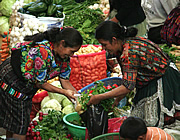
It was fascinating to see local Mayan customs in Chichicastenango and the bustling market.
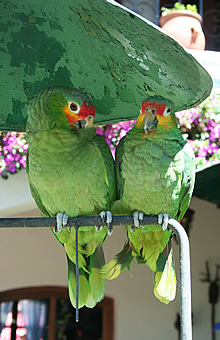
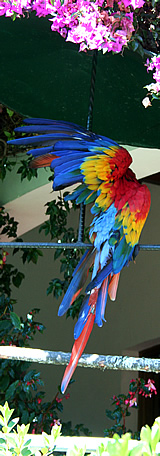
Before returning to Antigua from Lake Atitlan we visited Chichicastenango, a town celebrated for its Sunday market - luckily it was Sunday!
We travelled through very fertile agricultural land, stopping at a check point to ensure we weren't bringing any prohibited fruits into a fruit-growing region.
Mario entertained us with stories from the Popol Vuh, a collection of myths and legends about the Hero Twins including a virgin birth, flood story and treachery between gods and mortals.
Arriving in Chichi we went to the Hotel Santo Tomás, our meeting point if necessary and where we would have lunch.
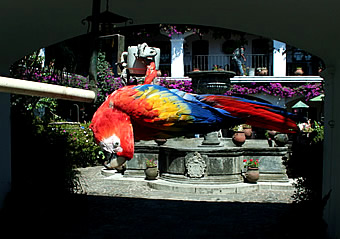
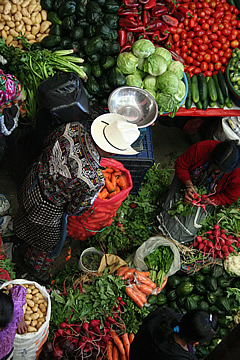
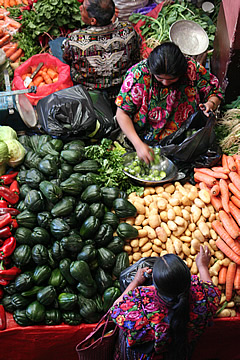
Chichi has the largest open-air market in Guatemala and though the population are mostly Ladinos, Quiché Indians come from villages for miles around to buy and trade. It is a bit touristy, though, as its relatively easily accessible, and we were pestered by people, especially children, selling masks, musical instruments or touting for their particular family shop.
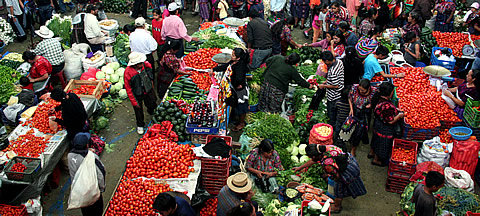
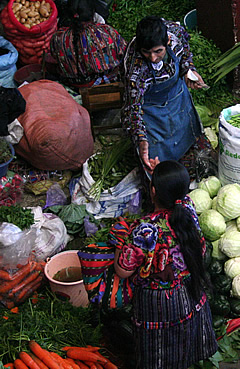
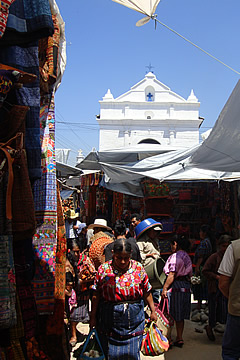
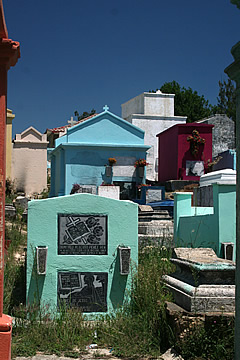
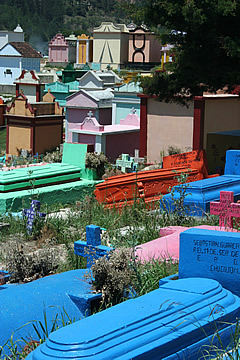
Mario first took us to the small, fruit and vegetable market held in what otherwise is a basketball court. Growers come from other regions to sell produce such as tomatoes, onions and potatoes which aren't grown here.
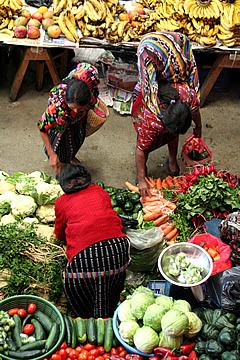
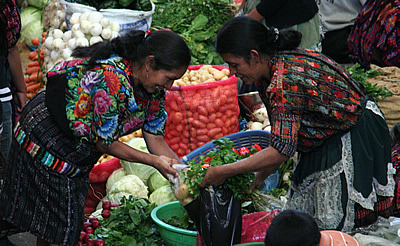
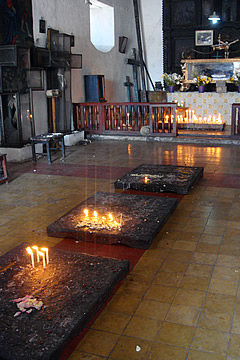
It's always fun to watch the hustle and bustle of a market.
We then went down through the main market where colourful clothing, bags, etc. were being sold. Though Mario had warned us to be careful and on the lookout for pickpockets and thieves Andrew was very nearly robbed - a thief unzipped a trouser pocket but didn't manage to get the wallet - we were even more careful after that.
We passed by the church of Santo Tomás where flower sellers had covered the steps to either side with their wares. Inside this Catholic church, built on an ancient Mayan spiritual site, there are also candle-bedecked Mayan altars, used by the Shamans for traditional rituals. Nearby is the Dominican Monastery where the Popol Vuh was transcribed in the 18th century by a Dominican priest, Father Ximénez, and this is now the only source available.
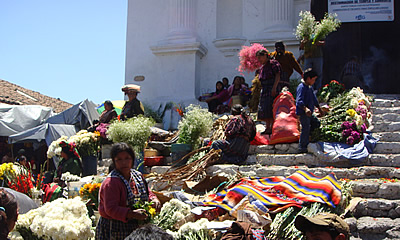
We found the outdoor market crowded, touristy and not so atmospheric so were glad to get out into the open away from the busy streets.
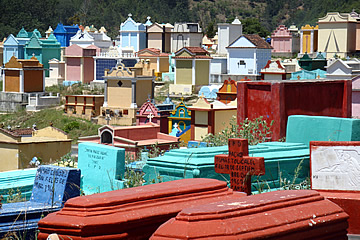
Mario took us to the colourful cemetery where a ten niche mausoleum will set a family back about $4000. Poor familes can rent spaces in public niches. They must pay for seven years to begin with then continue paying if they want to keep the space, otherwise the remains are removed and left on a pile of bones. Very poor people are buried directly into the ground.
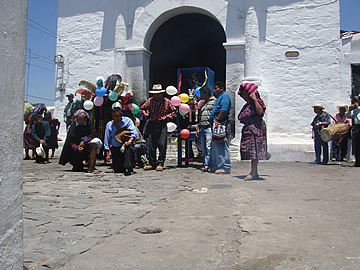
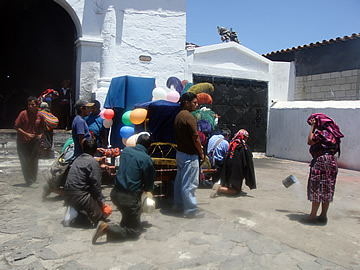
Here too there are Mayan ceremonial altars and several had burning fires from recent use. For the local people this is not a sinister place and families will come with a picnic to the grave of a loved one.
Mario asked us if we'd liked to climb the hill on the other side of the town where there is another Mayan shrine, warning us it was quite a haul, especially in the heat, but we were keen to do this rather than wander the market.
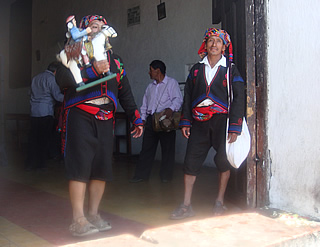
As we walked through the town we passed the Church of Calvario, across the plaza from Santo Tomás, and on its forecourt, reached by another impressive set of steps, there was a Mayan ceremony being performed. Mario said it would be OK to go up and watch and I made a donation to the participants in black at the church door so that I could take photographs and video.
I'm not too sure what was going on but there was a mariachi band and a group of people carrying perhaps saints in little covered shrines decorated with balloons and feathers. One contained a model of a man carrying a cross on a white horse - one of the men at the church door carried a smaller model of a man on a white horse. The group turned to face the four cardinal points, kneeling and bowing their heads, while a woman swung a can containing some kind of burning incense. One of the men in black then lit a firecracker in a metal cage and danced in front of the group of people and then they all left down the steps of the church. Fascinating.
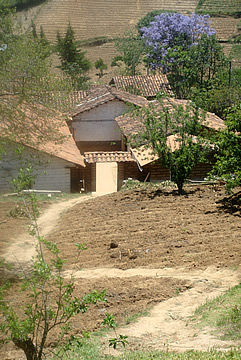
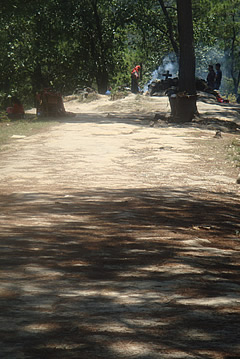
We continued on our walk. passing through a family's land - Mario knows the family who also have a textile museum - and on up a steepish hill.

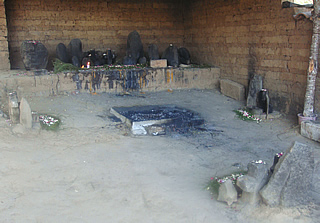
We stopped at the family's own ceremonial area which had a fire pit and a long stone "altar" with rounded stones, crosses, grasses, flowers and candles. Opposite the altar and on the other two side of the enclosure were smaller crosses and stones with flowers and grasses - a covering of the four cardinal points again perhaps. The Catholic and Mayan traditions seem to be strongly mingled in Chichicastenango.
At the top of the hill there is a worn stone idol presiding over a Mayan ceremonial altar. A Shaman was conducting a ceremony, chanting while people knelt with candles and waited to cast items such as sugar and rum onto the fire. We kept a respectful distance.
We returned to the Hotel Santo Tomás and had a very good lunch and a couple of beers each - very thirsty after the heat of the town. Then we returned to Antigua for one more night at the lovely Hotel Palacio de Doña Leonor before leaving to drive to Honduras.
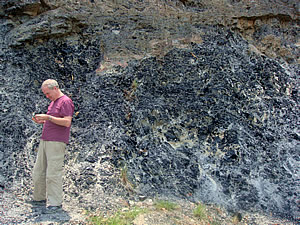
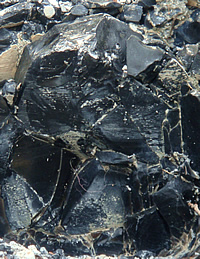
It was a seven hour trip, including a few stops along the way. We passed through Guatemala City and Mario made a detour to go through the centre so we could take a look - mostly monumental colonial and later buildings.
Mario, as usual, made the journey very interesting and our first short stop was at a Mayan obsidian quarry near San Antonio La Paz. This amazingly sharp, shiny black volcanic glass is one of the finest cutting tools ever produced, smooth at microscopic levels where steel scalpel blades look rough.
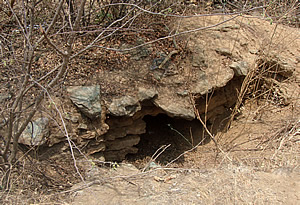
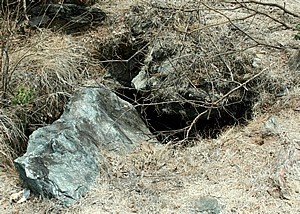
Further on we stopped again near San Cristóbal Acasaguastlán and walked from the road toward the Motagua River to the site of robbed-out Mayan graves from around 900AD, the covering stones broken and the contents removed.
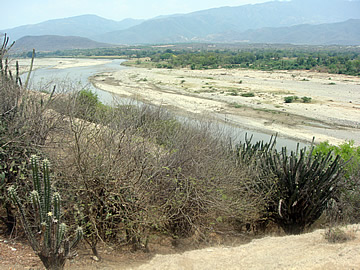
Despite being near a large river this area is very arid supporting many cactii as well as the Lignum tree which has very hard wood. Along the road we had been seeing Royal Poinciana trees with their vivid orange flowers and further on Mario pointed out cashew trees with orange or red fruit and the curved seed pod hanging below, inside which is the nut.
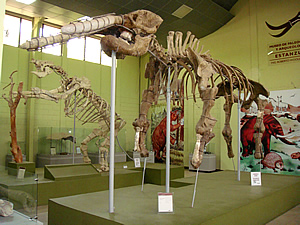
Turning south we stopped at Estanzuela to stretch our legs and visit the small but very good Museum of Paleontology and Archaeology.
It has several interesting prehistoric skeletons - the sloth is surprisingly large. There is also a reconstruction of a Mayan tomb complete with skull and offerings but there are no explanations in English so without a guide it's difficult to get much detail.
After a late lunch we crossed the border and Mario took us to our hotel. Mario was not licensed to guide us in Honduras so we looked around the ruins of Copan on our own. On the day we left Honduras Mario collected us early from our hotel and we set off back into Guatemala heading for Quiriguá.